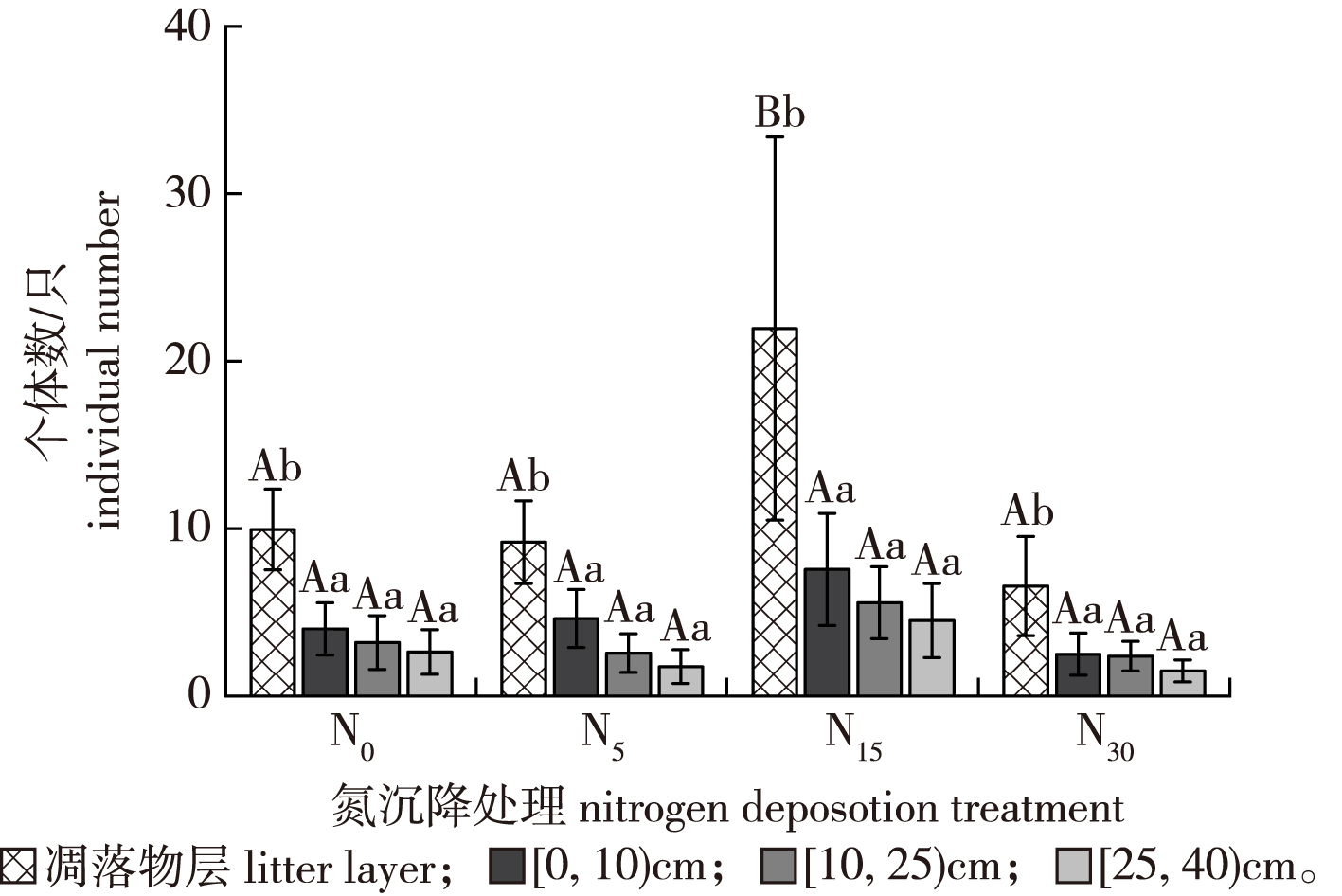 PDF(1883 KB)
PDF(1883 KB)


Effects of nitrogen addition on soil springtail(Collembolan) community in a poplar plantation
WANG Zimeng, RUAN Honghua, WU Xiaoqiao, YANG Yan, XIE Youchao, SHEN Caiqin, DING Xuenong, CAO Guohua
Journal of Nanjing Forestry University (Natural Sciences Edition) ›› 2024, Vol. 48 ›› Issue (4) : 243-253.
 PDF(1883 KB)
PDF(1883 KB)
 PDF(1883 KB)
PDF(1883 KB)
Effects of nitrogen addition on soil springtail(Collembolan) community in a poplar plantation
【Objective】Springtail(Collembolan species), as a kind of microarthropods widely distributed in soils, plays an important role in regulating the functions of soil ecosystems. However, the effects of nitrogen deposition on springtail communities in soils are poorly understood. This study aimed to elucidate the effects of nitrogen addition on springtail communities in soils by simulating nitrogen deposition for 10 years in a poplar plantation in Dongtai Forest Farm, Jiangsu Province.【Method】Four experimental treatments with different concentrations of nitrogen addition, i.e., the control (N0,No nitrogen addition), N5[5 g/(m2·a)], N15[15 g/(m2·a)], and N30[30 g/(m2·a)], were established in May 2012, respectively. A total of four replicate plots were prepared for each treatment, thus accounting for a total of 16 sample plots. The springtail communities in the litter and soil layers were analyzed in July 2021, October 2021, January 2022, and April 2022. The springtails in the litter layer were collected using a collection frame. Springtail samples were collected using soil drills with different diameters from the three soil layer at depths of 0 (floormas), 10 and 25 cm, respectively. Following transportation to the laboratory, the springtails were collected according to the Tullgren method, and the physical and chemical properties of the soil were analyzed. Statistical analysis was performed using SPSS 26 and Canoco 5.0.【Result】A total of 1 446 springtails, belonging to 4 Orders, 7 Families, and 18 Genera, were collected in this study. Of these, the Isoma, Toocerus, Entomobrya and Folsomia genera were the most abundant and accounted for 66.87% of the total number of individuals. The number of springtails in the soil increased significantly at a nitrogen concentration of 15 g/(m2·a), but decreased at a concentration of 30 g/(m2·a). The number of springtails in litter layer was significantly higher than that in the soil layer. The number of individuals varied across the seasons, in the following order: October (autumn) > July (summer) > April (spring) > January (winter). The Shannon-Wiener diversity index and Simpson dominance index were highest in the 15 g/(m2·a) treatment group, whereas the Pielou evenness index was highest for the 30 g/(m2·a) treatment group. The results of RDA analysis demonstrated that the pH, nitrate nitrogen content, and the C/N were the primary environmental factors that affected the distribution of springtails in the soil, and that different springtail populations responded differently to the environmental factors.【Conclusion】The results demonstrated that nitrogen deposition affected the composition of the springtail community in the soil. The findings further revealed that the application of nitrogen within a moderate concentration might increase the number and diversity of springtails; however, the excessive addition of nitrogen may reduce the number of springtails, thus indicating a threshold effect.

poplar / plantation / nitrogen addition / soil fauna / Collembola / community structure / community diversity
| [1] |
|
| [2] |
|
| [3] |
|
| [4] |
于美佳, 叶彦辉, 韩艳英, 等. 添加氮对森林生态系统影响的研究进展[J]. 安徽农业科学, 2021, 49(3):19-24,27.
|
| [5] |
|
| [6] |
徐国良, 莫江明, 周国逸. 模拟添加氮增加对南亚热带主要森林土壤动物的早期影响[J]. 应用生态学报, 2005, 16(7):1235-1240.
|
| [7] |
|
| [8] |
孙元, 兰晓萍, 邵红涛. 土栖弹尾虫环境指示作用研究进展[J]. 中国农学通报, 2014, 30(13):6-9.
|
| [9] |
|
| [10] |
|
| [11] |
|
| [12] |
|
| [13] |
|
| [14] |
|
| [15] |
崔海鸥, 刘珉. 我国第九次森林资源清查中的资源动态研究[J]. 西部林业科学, 2020, 49(5):90-95.
|
| [16] |
赵文芹, 席本野, 刘金强, 等. 不同灌溉条件下杨树人工林蒸腾过程及环境响应[J]. 植物生态学报, 2021, 45(4):370-382.
|
| [17] |
彭赛, 张雅坤, 葛之葳, 等. 添加氮对微生物分解森林地上凋落物过程的影响[J]. 南京林业大学学报(自然科学版), 2016, 40(1):1-7.
|
| [18] |
段娜, 李清河, 多普增, 等. 植物响应大气添加氮研究进展[J]. 世界林业研究, 2019, 32(4):6-11.
|
| [19] |
李德军, 莫江明, 方运霆, 等. 添加氮对森林植物的影响[J]. 生态学报, 2003, 23(9):1891-1900.
|
| [20] |
尹文英. 中国土壤动物检索图鉴[M]. 北京: 科学出版社, 1998.
|
| [21] |
|
| [22] |
|
| [23] |
张珂, 左鑫钰, 胡娅丽, 等. 塞罕坝不同植被类型地表土壤动物群落特征[J]. 林业与生态科学, 2022, 37(3):223-237.
|
| [24] |
|
| [25] |
宋敏. 增加降水及施氮对弃耕草地土壤线虫和小型节肢动物的影响[J]. 生态学杂志, 2017, 36(3):631-639.
|
| [26] |
李曾燕, 邱细容, 陈冠陶, 等. 多年模拟添加氮对华西雨屏区苦竹人工林土壤节肢动物的影响[J]. 生态学杂志, 2019, 38(5):1419-1425.
|
| [27] |
焦亚青. 土壤无机氮(铵态氮、硝态氮)时空变化研究现状[J]. 现代盐化工, 2022, 49(1):20-22.
|
| [28] |
|
| [29] |
薛璟花, 莫江明, 李炯, 等. 土壤微生物数量对模拟添加氮增加的早期响应[J]. 广西植物, 2007, 27(2):174-179,202.
|
| [30] |
费裕翀, 叶义全, 郑宏, 等. 外源氮素调控C/N比对杉木林凋落叶细菌群落结构的影响[J]. 生态学报, 2021, 41(5):2011-2023.
|
| [31] |
张春华, 王宗明, 居为民, 等. 松嫩平原玉米带土壤碳氮比的时空变异特征[J]. 环境科学, 2011, 32(5):1407-1414.
|
| [32] |
林英华, 黄庆海, 刘骅, 等. 长期耕作与长期定位施肥对农田土壤动物群落多样性的影响[J]. 中国农业科学, 2010, 43(11):2261-2269.
|
| [33] |
孙元, 邵红涛, 薛春梅, 等. 添加氮对我国森林生态系统生物多样性的影响研究进展[J]. 黑龙江大学工程学报, 2013, 4(2):33-37.
|
| [34] |
张燕, 张阿娟, 罗如熠, 等. 土壤跳虫对氮磷养分响应的研究进展[J]. 应用生态学报, 2022, 33(9):2585-2592.
|
| [35] |
肖辉林. 大气添加氮对森林土壤酸化的影响[J]. 林业科学, 2001, 37(4):111-116.
|
| [36] |
|
| [37] |
|
| [38] |
薛璟花, 莫江明, 李炯, 等. 添加氮增加对土壤微生物的影响[J]. 生态环境, 2005, 14(5):777-782.
|
| [39] |
郭超, 王霖娇. 添加氮对森林生态系统土壤微生物、酶活性以及细根生产与周转的影响研究进展[J]. 生态学杂志, 2021, 40(11):3730-3741.
|
| [40] |
|
| [41] |
|
| [42] |
|
| [43] |
|
| [44] |
李鹏, 李玉浸, 杨殿林, 等. 不同施氮处理对菠菜土壤硝态氮累积的影响[C]// 第十届中国科协年会论文集(二).郑州, 2008:1181-1186.
|
| [45] |
鲁显楷, 莫江明, 张炜, 等. 模拟大气添加氮对中国森林生态系统影响的研究进展[J]. 热带亚热带植物学报, 2019, 27(5):500-522.
|
| [46] |
|
| [47] |
徐国良, 莫江明, 周国逸. N沉降下土壤动物群落的响应:1年研究结果总述[J]. 北京林业大学学报, 2006, 28(3):1-7.
|
| [48] |
谢致敬, 常亮,
|
| [49] |
林青战. 牡丹区土壤动物多样性研究及弹尾目等节跳科昆虫系统分类[D]. 哈尔滨: 东北农业大学, 2016.
|
/
| 〈 |
|
〉 |